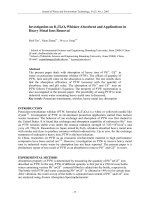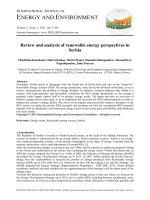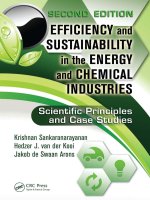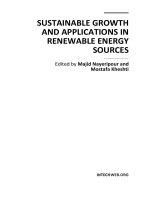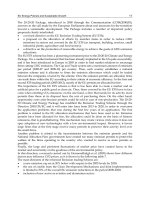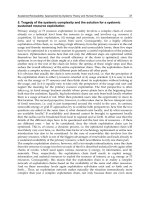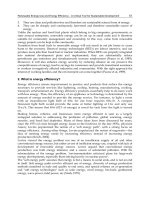Sustainable Growth and Applications in Renewable Energy Sources Part 12 potx
Bạn đang xem bản rút gọn của tài liệu. Xem và tải ngay bản đầy đủ của tài liệu tại đây (1.81 MB, 20 trang )
Biomass Energy Conversion
211
The Dulong equation is given by the following equation (1),
HV (kJ/kg) = 33,823*C + 144,250*(H-O/8) + 9,419*S
(1)
where C, H, O, N and S are the elemental mass fractions in the material.
Example. From the ultimate analysis data shown in Table 1, estimate the heating value in
MJ/kg of douglas fir.
Solution.
1. Substituting the mass fractions of the elements into the equation, we have
HV (kJ/kg) = 33,823*(0.523) + 144,250 (0.063-((0.405)/8)) + 9,419*(0)
2. Thus, the heating value is calculated as
HV (kJ/kg) = 17,689 + 1,785 + 0 = 19,474 kJ/kg (19.5 MJ/kg).
Note that the heating value from the table is given as 21.3 MJ/kg, an 8.45% difference. The
Dulong equation is valid when the oxygen content of the biomass is less than 10%. In this
example, the oxygen content of douglas fir is 40.5% and way above 10% , hence a large
difference.
The Boie equation is given by the following equation (2),
HV (kJ/kg) = 35,160*C + 116,225*H – 11,090*O + 6,280*N + 10,465*S
(2)
where C, H, O, N and S are the elemental mass fractions in the material.
2.2 Proximate analysis of biomass
The proximate analysis is a good indicator of biomass quality for further conversion and
processing. Proximate analysis is important for thermal conversion processes since the process
require relatively dry biomass (normally less than 10% moisture). If gaseous combustible fuel
from biomass is to be produced, the feedstock with the highest volatile matter content is ideal
to use. For slagging and fouling issues, the feedstock with the lowest ash content is an
excellent choice. The fixed carbon is used to relate the heating value of the product and co-
products. Table 2 shows some proximate analysis data for some biomass resources.
Material
Proximate Analysis
(% weight, wet basis)
Proximate Analysis
(% weight, dry basis)
MC VCM FC Ash VCM FC Ash
Corn cob
(Stout, 1985)
15.0 76.60 7.00 1.40 90.12 8.23 1.65
Stover (Stout, 1985) 35.0 54.60 7.15 3.25 84.00 11.00 5.00
CGT 9.01 64.78 14.36 11.85 71.20 15.78 13.02
Switchgrass 10.31 73.24 13.01 3.44 81.67 14.51 3.82
Sorghum 22.11 55.62 11.25 11.02 71.40 14.45 14.15
Woodchips 21.05 67.46 10.07 1.42 85.44 12.76 1.80
Table 2. Proximate analysis data for selected biomass.
3. Biomass conversion processes
The development of conversion technologies for the utilization of biomass resources for
energy is growing at a fast pace. Most developing countries find it hard to catch up because
Sustainable Growth and Applications in Renewable Energy Sources
212
the level of technology is beyond their manpower as well as their manufacturing and
technological capability. Added to this is the unavailability of local materials and parts for
the fabrication of these conversion units. Figure 1 shows the different methods for
converting biomass into convenient fuel. Biomass conversion into heat energy is still the
most efficient process but not all of energy requirement is in the form of heat. Biomass
resources need to be converted into chemical, electrical or mechanical energy in order to
have widespread use. These take the form of solid fuel like charcoal, liquid fuel like ethanol
or gaseous fuel like methane. These fuels can be used in a wide range of energy conversion
devices to satisfy the diverse energy needs. In general, conversion technologies for biomass
utilization may either be based on bio-chemical or thermo-chemical conversion processes.
Each process will be described separately.
Fig. 1. Methods of using biomass for energy.
3.1 Bio-chemical conversion processes
The two most important biochemical conversion processes are the anaerobic digestion and
fermentation processes.
3.1.1 Anaerobic digestion
Anaerobic digestion is the treatment of biomass with naturally occurring microorganisms in
the absence of air (oxygen) to produce a combustible gaseous fuel comprising primarily of
methane (CH
4
) and carbon dioxide (CO
2
) and traces of other gases such as nitrogen (N
2
) and
hydrogen sulphide (H
2
S). The gaseous mixtures is commonly termed “biogas”. Virtually all
nitrogen (N), phosphorus (P) and potassium (K) remain in the digested biomass.
The entire process takes place in three basic steps as shown in Figure 2. The first step is the
conversion of complex organic solids into soluble compounds by enzymatic hydrolysis. The
soluble organic material formed is then converted into mainly short-chain acids and
alcohols during the acidogenesis step. In the methanogenesis step, the products of the
second step are converted into gases by different species of strictly anaerobic bacteria. The
percentage of methane in the final mixture has been reported to vary between 50 to 80%. A
Biomass Energy Conversion
213
typical mixture consists of 65% methane and 35% CO
2
with traces of other gases. The
methane producing bacteria (called methanogenic bacteria) generally require a pH range for
growth of 6.4 to 7.2. The acid producing bacteria can withstand low pH. In doing their work,
the acid producing bacteria lower the pH and accumulate acids and salts of organic acids. If
the methane-forming organisms do not rapidly convert these products, the conditions
become adverse to methane formers. This is why the first type of reactors developed for
conversion of biomass wastes into methane have long retention times seeking equilibrium
between acid and methane formers.
Municipal wastes and livestock manures are the most suitable materials for anaerobic
digestion. In the US, numerous landfill facilities now recover methane and use it for power
generation. Aquatic biomass such as water hyacinth or micro-algae can be digested and may
become valuable sources of energy in the future. Anaerobic digestion of organic wastes may
constitute an effective device for pollution control with simultaneous energy generation and
nutrient conservation. A major advantage of anaerobic digestion is that it utilizes biomass
with high water contents of as high as 99%. Another advantage is the availability of
conversion systems in smaller units. Also the residue has fertilizer value and can be used in
crop production. The primary disadvantage of anaerobic digestion of diluted wastes is the
large quantity of sludge that must be disposed of after the digestion process including the
wastewater and the cost of biogas storage. In cold climates, a significant fraction of the gas
produced may be used to maintain the reactor operating temperature. Otherwise,
microorganisms that thrive on lower or moderate temperatures should be used.
(Source: American Chemical Society)
Fig. 2. Steps in anaerobic digestion process with energy flow represented as % chemical
oxygen demand (COD).
3.1.1.1 The first generation biogas reactors
Three main types of biogas facilities have been successfully developed in Asia for widespread
biogas production in households and industrial use. These are the “Chinese Digester” of fixed
dome type, the “Indian Gobar Gas Plant” of floating gas holder type and the rectangular
commercial size biogas digesters developed in Taiwan. These are what we may call the first
generation biogas reactors. Shown in Figure 3 is the common Chinese digester design. These
Sustainable Growth and Applications in Renewable Energy Sources
214
designs have eliminated the use of a floating gas holder and incorporated local materials for
construction (brick or concrete). Biogas is pressurized in the dome and can be easily used for
cooking and lighting. Figure 4 shows the “Indian Gobar Gas Plant” with floating gas holder.
Fig. 3. The “Chinese Digester” of the dome type.
Fig. 4. The “Indian Gobar Gas Plant” schematic showing cross-sectional design.
The Indian design uses concrete inlet and outlet tanks and reactor. The steel cover acts as the
floating gasholder. These digesters have no pumps, motors, mixing devices or other moving
parts and digestion takes place at ambient temperature. As fresh material is added each day,
digested slurry is displaced through an outlet pipe. The digesters contain a baffle in the
center which ensures proper utilization of the entire digester volume and prevents short
circuiting of fresh biomass material to the outlet pipe.
Biomass Energy Conversion
215
Figure 5 is an example of a rectangular biogas digester used in commercial swine facilities in
Taiwan. Similar reactors have been built and used in the Philippines for commercial swine
facilities (Maramba, 1978). The gas holder is designed and constructed separately.
Fig. 5. The Taiwan rectangular digester design with a separate gas holder.
While the above designs have been operated successfully, the reactors are still considered
World War II technologies. The main disadvantage is the long retention times of between 30
to 60 days. Thus, for large scale units, they require larger reactor volumes which make the
initial cost and area requirements quite high. Their main advantage is the fact that these
units have less maintenance and operational costs and they are less prone to breakdowns
due to variations in the quantity and quality of feed. They are resistant to shock loadings
and minimal process parameters are monitored for efficient operation. The only operating
procedure made is the daily mixing of the slurry.
3.1.1.2 The second generation biogas digesters
There are now new technologies which we may call the second generation biogas digesters.
These high rate bio-reactors were originally designed for low strength liquid wastes but the
progress has been remarkable and most units can now be used for even the high strength
wastes with high quantities of suspended solids like those of livestock manure.
Callander, et al., (1983), have made an extensive review of the development of the high rate
digester technology. The improvements of such digesters can be largely attributed to better
understanding of the microbiology of the methane production process. The most popular
high rate anaerobic digesters originated from many conventional wastewater treatment
plants that utilizes the anaerobic contact process (Figure 6) followed by the anaerobic
clarigester. Perhaps the design that has caused widespread attention is the development of
the upflow anaerobic sludge blanket (UASB) developed in Netherlands (Letingga, et al.,
1980). Many commercial high rate digesters are now based on this design. Other reactors
include the anaerobic filters (Young, et. al., 1969), the expanded bed fixed film reactor, and
the stationary fixed film reactor.
As researchers began to understand the microbiology of the processes, they began to realize
the varied nature and characteristics of the microorganisms used in the conversion. Thus
recent designs call for the separation of two types of microorganisms in the reactors. Some
new reactors are designed whereby acid forming bacteria are separated from the methane
producing bacteria. With this design, the acid formers are now independent from the
methane formers and therefore each group of microorganisms can do its job without
harming the population of the other types of microorganisms.
The retention times have been reduced for most of the high rate biogas digesters and thus
reducing the size of the digesters. However, there are corresponding need for a modest
Sustainable Growth and Applications in Renewable Energy Sources
216
laboratory for microbial analysis, system pH control and monitoring of other parameters
such as buffering capacity, solids retention times, alkalinity and the like.
Fig. 6. Some examples of second generation biogas digesters.
3.1.2 Ethanol fermentation
Ethyl alcohol can be produced from a variety of sugar containing materials by fermentation
with yeasts. Strains of Saccharomyces cerevisiae are usually selected to carry on the
fermentation that converts glucose (C
6
H
12
O
6
) into ethyl alcohol (C
2
H
5
OH) and carbon
dioxide (CO
2
). In the batch process the substrate is diluted to a sugar content of about 20%
by weight, acidified to ph 4-5, 8-10%, the liquid is distilled, fractionated and rectified. One
gallon of alcohol (3.79 liters, 21257 kcal) is obtained from 2.5 gallons of cane molasses or the
equivalent of 5.85 kg of sugar (21,842 kcal). So there is almost no energy loss in the
fermentation process.
When a starchy material, such a corn, grain sorghum or barley, is used as substrate, the
starch must be converted into fermentable sugars before yeast fermentation. The
Biomass Energy Conversion
217
decomposition of large organic molecules requires the catalytic action of certain enzymes
also produced by microorganisms. The most popular microbe is the Aspegillus niger.
Crops mentioned as potential substrate for the production of alcohol include sugarcane,
sorghum, cassava, and sugar beets. The two main by-products of then fermentation are CO
2
and the spent materials, which will contain the non-fermentable fraction of the substrate, the
non-fermented sugars and the yeast cells. The two most important reasons for the high costs
for ethanol production are: the batch nature of the process and the end-product (ethanol)
inhibition of the yeast.
Continuous fermentation has been found successful on a laboratory scale. One way of
avoiding end product inhibition is operation under vacuum so that ethanol is removed as it
is formed. More researches are underway. Figure 7 shows a schematic diagram for the
production of high percent ethanol from cassava (NRC, 1983).
Fig. 7. Schematic of ethanol production from cassava.
If the feedstock is high in cellulosic components, these must be hydrolyzed also by a
different sets of enzymes to break down the long chain cellulose structure into shorter chain
compounds. In our laboratory facilities, we made use of enzymes produced by Trichoderma
reesi. Commercially, genetically modified T. reesi may be sourced from Genencor
International (Palo Alto, California, USA).
3.2 Thermo-chemical conversion processes
Biomass wastes can be easily converted into other forms of energy at high temperatures,
They break down to form smaller and less complex molecules both liquid and gaseous
including some solid products. Combustion represents a complete oxidation to carbon
dioxide (CO
2
) and water (H
2
O). By controlling the process using a combination of
temperature, pressures and various catalysts, and through limiting the oxygen supply,
partial breakdown can be achieved to yield a variety of useful fuels. The main thermo-
chemical conversion approaches are as follows: pyrolysis/charcoal production, gasification
Sustainable Growth and Applications in Renewable Energy Sources
218
and combustion. The advantages of thermo-chemical conversion processes include the
following:
a. Rapid completion of reactions
b. Large volume reduction of biomass
c. Range of liquid, solid and gaseous products are produced
d. Some processes do not require additional heat to complete the process
3.2.1 Pyrolysis
Pyrolysis or destructive distillation is an irreversible chemical change caused by the action
of heat in the absence of oxygen. Pyrolysis of biomass leads to gases, liquids and solid
residues. The important components of pyrolysis gas in most cases are hydrogen, carbon
monoxide, carbon dioxide, methane and lesser quantities of other hydrocarbons (C
2
H
4
,
C
2
H
6
, etc.). The liquid consists of methanol, acetic acid, acetone, water and tar. The solid
residue consists of carbon and ash. Thus pyrolysis can be used to convert biomass into
valuable chemicals and industrial feedstock.
In a typical pyrolysis process the feed material goes through the following operations: (a)
primary shredding (b) drying the shredded material (c) removal of organics (d) further
shredding to fine size (e) pyrolysis (f) cooling of the products to condense the liquids and (g)
storage of the products.
Different types of pyrolytic reactors include vertical shaft reactors, horizontal beds. Among
these, the simplest and generally cheapest is the vertical shaft type. Fluidized bed reactors
are relatively a recent development. Figure 8 shows a rotary kiln pyrolysis reactor. The unit
is cylindrical, slightly inclined and rotates slowly which causes the biomass to move
through the kiln to the discharge end.
Numerous technologies have now been developed for the production of bio-oil and char
using the pyrolysis process, Many of the reactors developed are improvements on the
traditional reactors used in rural areas of developing countries that include simple pit kilns
or drum type reactors. The energy efficiency of charcoal production using these methods is
only the order of 17-29% while theoretically, efficiencies as high as 40% could be achieved.
Fig. 8. Schematic of the rotary kiln pyrolysis reactor.
Biomass Energy Conversion
219
3.2.2 Gasification
Gasification is the thermo-chemical process of converting biomass waste into a low
medium energy gas utilizing sub-stoichiometric amounts of oxidant (Coovattanachai,
1991). The simplest form of gasification is air gasification in which biomass is subjected to
partial combustion with a limited supply of air. Air gasifiers are simple, cheap and
reliable. Their chief drawback is that the gas produced is diluted with nitrogen and hence
has low calorific value. The gas produced is uneconomical to distribute; it must be used
on-site for process heat. In oxygen gasification, pure oxygen is used so that the gas
produced is of high energy content. The chief disadvantage of oxygen gasification is that
it requires an oxygen plant and thus increases the total cost of gasification. The schematic
diagram of the processes occurring is a gasifier is shown in Figure 9 including the
temperature profile at each important step in the process.
Fig. 9. Schematic diagram of processes occurring in a gasifier and the temperature profile.
The simplest air gasifier is the updraft gasifier shown in Figure 10. Air is introduced at
the bottom of the bed of biomass near the hearth zone. The gas produced is usually at a
low temperature. The sensible heat of the gas is used to dry and preheat the biomass
before it reaches the reduction zone. Products from the distillation and drying zones
consist mainly of water vapor, tar and oil vapors and are not passed through the hot bed.
They therefore leave the reactor uncracked and will later condense at temperatures
between 125
o
C – 400
o
C.
Because the tar vapors leaving an updraft gas producer seriously interfere with the
operation of internal combustion engines, the downdraft gasifiers (Barret, et. al., 1985) are
more extensively used. The air is introduced into a downward flowing bed of solid fuel and
the gas outlet is at the bottom as shown in Figure 11. The tarry oils and vapors given off in
Sustainable Growth and Applications in Renewable Energy Sources
220
the distillation zone are cracked and reduced to non-condensible gaseous products while
passing through the oxidation (hearth) zone. Downdraft gasifiers have a reduced cross-
sectional area above which the air is introduced. The throat ensures a homogeneous layer of
hot carbon through which the distillation gases must pass.
Fig. 10. Schematic diagram of an updraft gasifier.
The crossdraft gasifier is also a fixed bed gasifier where the feed material could be moved by
gravity while the flow of air is at an angle against the feed flow. The usual flow of air is
perpendicular to the flow of biomass. They have almost the same performance as the
updraft and downdraft gasifiers.
A fluidized bed gasifier (LePori and Soltes, 1985) consists of a fluidized bed of inert
particles in which biomass is fed. The gas stream generally carries with it the char
particles out of the bed. These particles are separated from the gas by means of cyclones.
Fluidized beds can gasify much higher amounts of biomass area per unit of time
compared to the other types of gasifiers. The precise composition of the gas from the
gasifiers depends on the type of biomass used, the temperature and rate of reaction.
Typically, if wood is used as the feed, the gas composition is shown in Table 3. The heat
content is about 5500 kJ/m
3
. The synthesis gas quality for the Texas A&M University
fluidized bed gasifier is shown in Table 4 (Lepori, 1985). A schematic of a fluidized bed
gasifier is shown in Figure 12.
Biomass Energy Conversion
221
Fig. 11. Schematic diagram of a downdraft draft gasifier.
Fig. 12. Schematic diagram of a fluidized bed gasifier.
Sustainable Growth and Applications in Renewable Energy Sources
222
Type of Gas Percent Composition
1. Carbon dioxide (CO
2
) 10%
2. Carbon monoxide (CO) 20-22%
3. Hydrogen (H
2
) 12-15%
4. Methane (CH
4
) 2-3%
5. Nitrogen (N
2
) 50-53%
Table 3. Typical gas composition of a fluidized bed gasifier using wood as feedstock.
Type of Gas Percent Composition
1. Carbon dioxide (CO
2
) 18.25%
2. Carbon monoxide (CO) 13.44%
3. Hydrogen (H
2
) 14.68%
4. Methane (CH
4
) 3.21%
5. Nitrogen (N
2
) 47.31%
6. Ethylene (C
2
H
4
) 1.83%
7. Ethane (C
2
H
6
) 0.36%
Table 4. Typical gas composition of the TAMU fluidized bed gasifier.
3.2.3 Biomass combustion
One of the most common methods of biomass conversion is by direct combustion or
burning. The simplest units include numerous cookstoves already developed in rural areas
of developing countries. Much improved and continuous flow designs include the Spreader-
Stoker system (similar to that shown in Figure 13) used in many refuse derived fuels (RDF)
facility for converting solid wastes, and the fluidized bed combustion units (similar to that
shown in Figure 12). The number component parts of this system is listed below:
1. Refuse charging hopper
2. Refuse charging throat
3. Charging ram
4. Grates
5. Roller bearings
6. Hydraulic power cylinders and control valves
7. Vertical drop-off
8. Overfire air jets
9. Combustion air
10. Automatic sifting removal system
In a spreader-stoker system, the fuel is introduced into the firebox above a grate. Smaller
particles will tend to burn in suspension and larger pieces will fall onto the grate. Most
units, if properly designed, can handle biomass with moisture content as high as 50-55%.
Moisture contained in the fuel is driven off partially when the fuel is in suspension and
partially on the grate. The feed system should provide an even thin layer of fuel on the
grate.
In a fluidized bed combustor (FBC), the fuel particle burns in a fluidized bed of inert particles
utilizing oxygen from the air. Advantages of fluidized bed combustion include: (1) high heat
transfer rate, (2) increased combustion intensity compared to conventional combustors and, (3)
Biomass Energy Conversion
223
absence of fouling and deposits on heat transfer surfaces. The schematic diagram of a fluidized
bed combustor is similar to that of a fluidized bed gasifier. The only difference is the use of
excess air for combustion processes and starved air for gasification processes.
So far FBC has been used mostly for coals. A number of wastes, e.g. wastes from coal mining
and municipal wastes, are also sometimes incinerated in fluidized beds. It has been
suggested that certain quick-maturing varieties of wood could be combusted in fluidized
beds for generation of steam. There is indeed a global search for suitable varieties of wood
for this purpose and FBC is likely to play an important role in supplying energy
requirements in certain countries in the future.
Fig. 13. Schematic diagram of a reciprocating grate combustor (Courtesy of Detroit
Reciprogate Stocker).
Granular biomass fuels, e.g. paddy husk and chips of wood up to 2cm x 2cm x 2cm in size
have been successfully combusted in fluidized beds of sand particles. Conventional
combustion of paddy husk is slow and inefficient. Nearly complete combustion and high
combustion intensities of paddy husk can be achieved in a fluidized bed combustor. The
same combustor can also be used for burning wood. Combustion intensities up to about 500
Kg/hr-m
2
have been achieved in fluidized bed combustors using biomass fuels.
A number of thermo-chemical conversion processes exist for converting biomass into liquid
fuels. These can be crudely divided into direct liquefaction and indirect liquefaction (in
which the biomass is gasified as a preliminary step) processes. While all these techniques are
relatively sophisticated and will generally be suitable for large scale conversion facilities,
Sustainable Growth and Applications in Renewable Energy Sources
224
they do represent an important energy option for the future because the heavy premium
that liquid fuels carry.
The steam produced from heat of combustion of biomass may power a steam turbine to
produce electricity. However, because of the high ash contents of most biomass resources,
direct combustion of these biomass resources is not practical and efficient due to slagging
and fouling problems. Because of these problems, some biomass with high ash are often
mixed with low ash biomass such as coal, also termed co-firing.
3.2.4 Biomass co-firing
Co-firing refers to mixing biomass and fossil fuels in conventional power plants. Significant
reductions in sulfur dioxide (SO
2
– an air pollutant released when coal is burned) emissions
are achieved using co-firing systems in power plants that use coal as input fuel. Small-scale
studies at Texas A&M University show that co-firing of manure with coal may also reduce
nitrogen oxides (NOx- contribute to air pollution) emissions from coal (Carlin, 2009).
Manure contains ammonia (NH
3
). Upon co-firing manure and coal, NH
3
is released from
manure
and combines with NOx to produce harmless N and water.
Biomass co-firing has the potential to cut emissions from coal powered plants without
significantly increasing the cost of infrasructure investments (Neville, 2011). Research shows
that when implemented at relatively low biomass-to-coal ratios, energy consuption, solid
waste generation and emissions are all reduced. However, mixing biomass and coal
(especially manure) does create some challenges that must be address.
There are three types of co-firing systems adopted around the world as follows:
a. Direct co-firing
b. Indirect co-firing , and
c. Separate biomass co-firing.
Direct co-firing is the simplest of the three and the most common option especially if the
biomass have very similar characteristics with coal. In this process, more than one type of fuel
is injected into the furnace at the same time. Indirect co-firing involves converting the biomass
into gaseous form before firing. The last type has a separate boiler for the co-fired fuel.
It was reported that the carbon life cycle and energy balance when co-firing 15% biomass
with coal is carbon neutral or better (Eisenstat, et al., 2009). In this research, carbon
emissions are reduced by 18%.
4. Conclusion
From the above discussions we observe a rapid development of technologies for the
conversion of biomass into heat energy and fuels. Countries should take advantage of these
rapidly developing technologies. However, as more conversion technologies are developed,
the biomass resource base may be the next constraint. Thus, methods to diversify the biomass
resource base have to be made in conjunction with the use of emerging technologies for
conversion. The sources of biomass have to be broadened from the traditional crop residues,
livestock manure and fuel wood to culturing energy crops such as aquatic biomass (e.g. algae)
while recovering the energy from municipal solid wastes and sewage.
Attempt has to be made to make use of more efficient equipment and technologies for
energy utilization. In anaerobic digestion for example, many countries are still utilizing age
old first generation anaerobic reactors while high rate biogas reactors are already gaining
Biomass Energy Conversion
225
popularity. In the implementation of new and emerging technologies, lessons learned from
past experiences must be taken into consideration. Many of these technologies require
highly qualified and skilful manpower, more advanced monitoring techniques and
equipment and materials that many developing countries may not have. The government of
each country should have an active role to support the developing of such technologies
including massive information campaign and training and improvement of local expertise
in the use of advanced materials and process equipment for biomass conversion into energy
and fuels.
Finally, to reverse the trend in the depletion of agriculture and forestry resources, massive
reforestation program must be made together with developing technologies for harvesting,
pre-processing and storage of biomass. This should be implemented together with
infrastructure development for efficient transport of biomass to where it is needed or
develop technologies that will be brought to where biomass resources are abundant.
5. References
Annamalai, K, J. M. Sweeten and S. C. Ramalingam. 1987. Estimation of Gross heating
Values of Biomass Fuels. Transactions of the ASAE, American Society of
Agricultural Engineers, Vol. 30(4): 1205-1208.
Barret, J.R., R.B. Jacko and C.B. Richey. 1985. Downdraft Channel Gasifier Furnace for
Biomass Fuels. Transactions of the ASAE, American Society of Agricultural
Engineers. Vol. (32): 592-598. St. Joseph, MI.
Callander, I.J. and J.P. Barford. 1983. Recent Advances in Anaerobic Digestion Technology.
Proc. Biochem. 18(4):24-30 and 37.
Carlin, N. T. 2009. Optimum Usage and Economic Feasibility of Animal Manure-Based
Biomass in Combustion Systems. Ph.D. Dissertation, Department of Mechanical
Engineering, Texas A&M University, College Station, Texas.
Coovattanachai, N. 1991. Gasification of Husk for Small Scale Power Generation. RERIC
International Energy Journal. 13(1):1-17.
Eisenstat, L., A. Weinstein and S. Wellner. 2009. Biomass Co-firing: Another Way to Clean
Your Coal. Power Vol. 153 Issue 7, 68-71 (July 2009).
Energy Information Administration. 2002. Annual Energy Outlook. DOE/EIA-0383 (2002).
Washington, DC. USA.
Gupta, S. C. and P. Manhas. 2008. Percentage Generation and Estimated Energy Content of
Municipal Solid Waste at Commercial Area of Janipur, Jammu. Environmental
Conservation Journal 9(1): 27-31.
Haq, Zia. 2002. Biomass for Electricity Generation. EIA, US Department of Energy, 1000
Independence Ave., SW, Washington, DC. USA.
LePori, W.A. 1985. Thermo-chemical Conversion of Biomass Using Fluidized Bed
Technology. ASAE Paper No. 85-3701, ASAE, St. Joseph, MI 49085.
LePori, W. A. and E. J. Soltes. 1985. Thermochemical Conversion for Energy and Fuel. In :
Biomass Energy : A Monograph. E. A. Hiler and B. A. Stout : Editors. Texas A&M
University Press, College Station, Texas, USA.
Lettinga, G., A.F.M. Van Velsen, S.W. Homba, W. de Zeeuw, and A. Klapwijk. 1980. Use of
the Upflow Sludge Blanket (USB) Reactor Concept for Biological Wastewater
Treatment, Especially for Anaerobic Treatment. Biotech and Bioengineering. 22:699-
734.
Sustainable Growth and Applications in Renewable Energy Sources
226
Maramba, F.D. Sr. 1978. Biogas and Waste Recycling. Regal Printing Company, Manila
Philippines.
National Research Council (NRC) of America. 1983. Alcohol Fuels: Options for Developing
Countries. 1983. Report of an Ad Hoc Panel of the Advisory Committee on
Technology Innovation, Board on Science and Technology for Internal
Development, Office of Internal Affairs, National Research Council. National
Academy Press, Washington, D.C.
Neville, A. 2011. Biomass Co-firing: A Promising New Generation Option. Power, Volume
155 (4): 52-56 (April 2011).
Stout, B. A. 1984. Energy Use and Management in Agriculture. Breton Publishers. North
Scituate, Massachusetts.
Victor, N. M. and D. G. Victor. 2002. Macro Patterns in the Use of Traditional Biomass Fuels.
Report on Stanford/TERI Workshop on “Rural Energy Transitions” held in New
Delhi, India on November 5-7, 2002. Stanford University, Palo Alto, California,
USA.
Young, J.C. and P.L. McCarty. 1969. The Anaerobic Filter for Waste Treatment. JWPCF. 41:r
160.
11
Air Gasification of Malaysia Agricultural Waste
in a Fluidized Bed Gasifier: Hydrogen
Production Performance
Wan Azlina Wan Ab Karim Ghani
1,2
, Reza A. Moghadam
1
and
Mohamad Amran Mohd Salleh
1,2
1
Department of Chemical and Environmental Engineering,
The Universiti Putra Malaysia, Serdang, Selangor,
2
Green Engineering and Sustainable Technology Lab, Institute of Advanced
Technology(ITMA), Universiti Putra Malaysia, Serdang, Selangor,
Malaysia
1. Introduction
Recently, biomass gasification technology to produce hydrogen-rich fuel gas is highly
interesting possibilities for biomass utilization as sustainable energy (McKendry, 2002).
Hydrogen production from biomass gasification has many advantages as secondary
renewable energy source as it is the universe’s most abundant element, clean fuel has the
potential to serve as renewable gaseous and liquid fuel for transportation vehicles. As a fuel,
hydrogen is considered to be very clean as it releases no carbon or sulfur emissions upon
combustion. The energy contained in hydrogen on a mass basis (120 MJ/kg) is much higher
than coal (35 MJ/kg), gasoline (47 MJ/kg) and natural gas (49.9 MJ/kg). Additionally, the
most important advantage for all the living beings is that when it is burned, hydrogen
produces non toxic exhaust emissions. Clearly, the emissions from hydrogen combustion
contain no carbon monoxide (CO), carbon dioxide (CO
2
) and unburned hydrocarbons
(Veziroglu et al., 2005). Using biomass as an energy source can reduce the greenhouse gas
emission that causes global warming which is a negative effect of using fossil fuels as an
energy source.
In Malaysia, more than 2 million tonnes of agricultural wastes are produced annually and
potentially an attractive feedstock for producing energy as the usage contributes little or no
net carbon dioxide to the atmosphere. Major agricultural products are oil palms, sawlogs,
paddy and tropical fruits. The palm oil sector is the biggest producer and hence the major
contributor to the agricutural residues generation in Malaysia. The oil-palm solid wastes
(including shell, fibre and Empty Fruit Bunch (EFB)) are abandoned materials produced
during palm oil milling process. For every ton of oil-palm fruit bunch being fed to the palm-
oil refining process, about 0.07 tons of palm shell, 0.146 tons of palm fiber and 0.2 tons of
EFB are produced as the solid wastes. Bagasse which is the matted cellulose fibre residue
from sugar cane that has been processed in a sugar mill were produced about 3×10
5
T per
year in 1999. Despite the decreasing acreage, coconut still plays an important role in the
Sustainable Growth and Applications in Renewable Energy Sources
228
socio-economic position of the Malaysian rural population that involves 80,000 households.
About 63% of coconut production, coconut fronds and shells represent the largest amount as
residues (about 8%) (Ninth Malaysia Plan 2006-2010). Table 1 summarize the estimations of
the current and potential selected agicultural wastes (biomass) utilizations in annual energy
productivity in Malaysia.
Thermo-chemical conversion processes, including gasification, pyrolysis and combustion
have been proven the best available technology to convert these renewable materials into
valuables fuel (hydrogen) and fine chemical feedstock. However gasification process offers
technologically more attractive and useful options for medium and large scale applications
due to presence of non–oxidation conditions and lower green house gases emission.
Fluidized bed gasifier is proven to be a versatile technology capable of burning practically
any wastes combination with low emissions. The significant advantages of fluidized bed
gasifier over conventional gasifiers include their compact furnaces, simple designs, effective
gasification of wide variety of fuels, relatively uniform temperatures and ability to reduce
emissions of carbon dioxide, nitrogen oxides and sulfur dioxides.
Crops/
Activities
Energy
productivity
(boe/ha/year)
Current Annual
Amount Used for Energy
Purposes
Current Annual Energy
Potential of Utilised
Biomass (million boe)
Oil Palms 88.7
Fruit shells
Fruit fibres
Effluents
23.609
13.630
0.022
Pruned fronds
EFB
Effluents
Replanting
wastes
77.665
11.444
2.928
12.94
Rubber
trees
29.5 Wood 4.967
Wood
Effluents
3.707
0.210
Paddy
plants
11.54
Rice husks
Rice straws
1.025
2.541
Coconut
trees
28.21
Fronds
Shells
1.578
0.785
Fronds
0.164
Cocoa trees 80.33 N.A. N.A.
Pruning
wastes
Pod husks
Replanting
wastes
16.850
0.085
0.630
Sugarcane 54.9 Bagasse 0.421
Leaves and
tops
0.298
Logging - - Residues 19.060
Timber
processing
-
Sawdust &
waste
3.733
Tree bark and
sawdust
1.0
Table 1. Estimates of the energy productivity and biomass production and utilization (Ninth
Malaysia Plan 2006-2010)
Air Gasification of Malaysia Agricultural Waste in a
Fluidized Bed Gasifier: Hydrogen Production Performance
229
1.1 Hydrogen fuel
Technology development for conversion of waste feedstock to hydrogen has an economical
potential. Depletion of fossil fuel source such as oil, gas and coal is going to become the
biggest problem in the near future. Therefore, hydrogen fuel from the biomass waste is the
best supersede for fossil fuels. Hydrogen is not widely used today but it has a great
potential as an energy carrier such as fuel cell that can be applied to power cars and factories
and also for home usages in the future. In comparison with fossil fuels, 9.5 kg of hydrogen
produce energy equivalent to that produced by 25 kg of gasoline (Mirza et al., 2009).
Hydrogen has the highest energy content of any common fuel by weight (about three times
more than gasoline). Hydrogen is an odorless, tasteless, colorless and non-poisonous gas. It
is a renewable resource found in all growing things. Hydrogen is an important raw material
for chemical, petroleum and agro-based industries. The demand for hydrogen in the
hydrotreating and hydrocracking of crude petroleum is steadily increasing (Min et al., 2005).
Hydrogen is catalytically combined with various intermediate processing streams and is
used in conjunction with catalytic cracking operations to convert heavy and unsaturated
compounds to lighter and more stable compounds. Large quantities of hydrogen were used
to purify gases such as argon that contain trace amounts of oxygen. Furthermore, in the food
and beverages industry, hydrogen was used for hydrogenation of unsaturated fatty acids in
animal and vegetable oils, to produce solid fat and other food products. While in
manufacturing of semi conducting layers in integrated circuits, hydrogen were used as a
carrier gas. The pharmaceutical industries use hydrogen to make vitamins and other
pharmaceutical products. Hydrogen is mixed with inert gases to obtain a reducing
atmosphere that is required for many applications in the metallurgical industry such as heat
treating steel and welding (Delgado et al., 1997 and Dupont et al., 2008).
In 2005, the overall U.S. hydrogen market is estimated at $798.1 million and it is expected
to rise to $1,605.3 million for U.S. and $740 million for European in 2010 (Keizai, 2005).
However, hydrogen production is not enough to uphold this value. The hydrogen
technology had been intensively studied to find a variety of hydrogen source with
different treatment processes because hydrogen has great potential as an
environmentally clean energy fuel and as a way to reduce reliance on imported energy
sources. In Asian region, the biomass from agriculture sector is the largest source of
hydrogen production. Many experts predict that hydrogen will eventually power
tomorrow’s industries and thereby may replace coal, oil and natural gas. However, it
will not happen until a strong framework of hydrogen production, storage, transport and
delivery is developed.
1.2 Biomass gasification
According to Xiao et al. (2007), it is generally reported by different authors that the process
of biomass gasification occurs through main three steps. At the first step in the initial
heating and pyrolysis, biomass is converted to gas, char and tar. Homogeneous gas-phase
reaction resulted in higher production of gaseous. High bed temperature during this phase
allowed further cracking of tar and char to gases. Second step is tar-cracking step that
favours high temperature reactions and more light hydrocarbons gases such as Hydrogen
(H
2
), carbon monoxide (CO), carbon dioxide (CO
2
) and methane (CH
4
). Third step is char
gasification step that is enhanced by the boudouard reaction.
The gasification mechanism of biomass particles might be described by the following
reactions:
Sustainable Growth and Applications in Renewable Energy Sources
230
Biomass Gas+ Tars + Char (1)
The Combustion reactions:
C + ½ O
2
CO -111 MJ/Kmol (2)
CO + ½ O
2
CO
2
-283 MJ/Kmol (3)
H
2
+ ½ O
2
H
2
O -242 MJ/Kmol (4)
The Boudouard reaction:
C + CO
2
2CO +172 MJ/Kmol (5)
The Water gas reaction:
C + H
2
O CO + H
2
+131 MJ/Kmol (6)
The Methanation reaction:
C + 2H
2
CH
4
-75 MJ/Kmol (7)
The Water gas shift (CO shift) reaction:
CO + H
2
O CO
2
+ H
2
-41 MJ/Kmol (8)
The gasification performance for optimized gas producer quality (yield, composition,
production of CO, H
2
, CO
2
and CH
4
and energy content) depends upon feedstock origin,
gasifier design and operating parameters such as temperatures, static bed height,
fluidizing velocity, equivalence ratio, oxidants, catalyst and others which are summarized
in Table 2.
In summary, most of performed researches have explored the effect of different gasifying
agent (air or steam) and applied different types of catalysts on gasification or pyrolysis
process. Temperature and equivalence ratio of biomass with fuel (either air or steam) is the
most significant parameter to contribute to the hydrogen production. However, less
emphasis has been given to experimental investigation on the optimization of pyrolysis and
gasification processes integration for the conversion of low value biomass into hydrogen
and value-added products, which is the focus of this paper.
2. Materials and experimental
2.1 Raw materials
Three types of agricultural residues were investigated in this research namely palm kernel
shell, coconut shell and bagasse as they are abundantly available in the agriculture sector in
Malaysia. The samples were open air dried for 2 to 3 days to remove moisture and to ease
crushing. Both of these samples were pulverized into powder and were sieved into specific
particle size of (0.1-0.3 mm). Sieving was accomplished by shaking the ground biomass
samples in a Endecotts Shaker Model (EFL2 MK3) for 30 minutes and dried in a vacuum
oven at 80°C overnight and were kept in a tightly screw cap bottle. Table 3 summarized fuel
properties investigated in this research.
